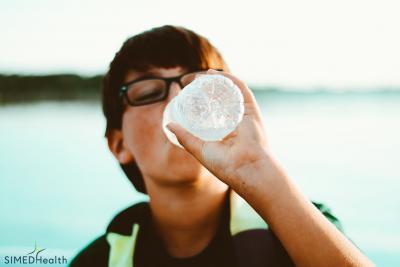
We all love summer. Kids and teens that don’t have to be in school during the summer are perhaps the happiest this time of year. It’s a chance to vacation, get in the water, and have more fun during these long, hot days.
However, more time to play and explore with the family also means more injury risks. Dr. David Lefkowitz of SIMEDHealth Primary Care sat down with us to provide tips on how to be safe this summer while having fun.
What are some of the most dangerous ailments you see during the summer?
Besides water-related injuries, the most dangerous summertime ailments are heat-related injuries. This includes a spectrum of issues from mild (heat cramps) to moderate (heat exhaustion) to severe (heat stroke).
Heat cramps occur during intense physical exertion in hot environments. Expect the person to be sweating heavily with cramps and muscle pain (which can occur in any muscles). Treatment includes resting, moving to a cool environment, drinking fluids (like Gatorade), and waiting for the symptoms to pass. Medical attention is usually not needed but should be sought if the cramps last longer than one hour.
Heat exhaustion is more severe and presents itself as profuse sweating with cold, clammy skin. People are often dizzy, weak, nauseated, and irritable. They may lack coordination and even pass out. Treatment includes moving to a cooler environment if possible, taking off or loosening clothes, applying cool wet towels, lying flat on your back, and drinking fluids (like Gatorade). Medical attention is usually not needed but should be sought if symptoms last longer than one hour or if they get worse.
Heat stroke is the most severe and can be fatal. At this point, the person’s core body temperature is over 104 degrees and they have altered thinking. This is a medical emergency and so 911 needs to be called a.s.a.p. However, if possible, it is advisable to help bring the person’s body temperature back down via whatever means are available. Immersing them (not the head) in a bath of ice water is the best method but that is not always available. At the very least, they should be moved to a cooler environment and covered with cold, wet towels. Do not give them fluids by mouth as they may choke (they need IV fluids).
 How can we prevent heat-related injuries and exposure to harmful UV rays?
How can we prevent heat-related injuries and exposure to harmful UV rays?
When people think of summer, they think of fun in the sun. However, the sun is our main source of exposure to ultraviolet (UV) rays. In the short-term, UV rays cause painful sunburns; in the long-term, they can cause skin cancer and premature skin aging.
The best and most obvious way of protecting oneself from harmful UV rays is simply to stay in the shade. When that’s not an option, it is best to stay covered with UV-protective clothing such as wide-brimmed hats and long-sleeved shirts (commonly called “rash guards”). Clothing that is made for UV-protection has a rating called the Ultraviolet Protection Factor (UPF) that goes from 15 to 50. For the best protection, aim for garments with a rating of 40 or higher.
OK, so going to the beach in pants and long sleeves just isn’t going to work for you? There’s always sunscreen. However, no sunscreen can block ALL ultraviolet rays. Because of this, it should not be relied upon as your only method of defense against these harmful rays. Sunscreens are rated using a scale called Sun Protection Factor (SPF) that goes from 15 to 100+. In general, aim for a sunscreen that is SPF 30 or higher, apply it to all sun-exposed areas 30 minutes before going out in the sun, and reapply every two hours or after swimming or toweling off. Also, make sure your sunscreen is broad spectrum (meaning it blocks both UVA and UVB rays).
And of course, don’t forget to protect your lips with SPF-rated lip balm and your eyes with UV-blocking sunglasses.
What are some summer safety tips for kids and families visiting pools and lakes?
- Even capable swimmers should swim with a buddy.
- Children need direct supervision when swimming. Things like “floaties,” “water wings” or “puddle jumpers” are NOT meant to replace direct supervision.
- Avoid jumping into bodies of water when the depth is not clearly marked. This is especially true for diving headfirst into rivers or lakes. This could lead to spinal cord injury, paralysis, or death.
- Most pools don’t have lifeguards. Therefore, the adults need to know basic CPR just in case.
- To prevent swimmer’s ear (ear canal infection), make a mixture of 1 part rubbing alcohol to 1 part white vinegar. Put a few drops of this solution in the ear canal after swimming.
Do you have any additional tips on how to prevent summer injuries?
On land, make sure you and your children are wearing proper safety gear such as helmets and pads when using bikes, scooters, and skateboards. Children should not drive ATVs unsupervised and anyone on an ATV should have full protective gear on (including a DOT-approved helmet).
On the water, the name of the game is prevention: preventing boating accidents and preventing drowning. Skippers should not be under the influence of alcohol and everyone on the boat should be wearing a life jacket.
All children should be supervised at all times to prevent drowning, even if they are capable swimmers (for example, rip currents can lead to drowning even in strong swimmers).
Need specialized tips for your family? Click here to request an appointment